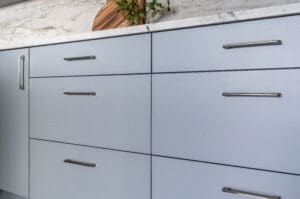When designing and planning your cabinetry and casework project, there are many options to the overall theme or style:
Contemporary, Traditional, Transitional, Casual, Elegant, Rustic
And many choices for door styles and finishes:
Painted, Stained Wood, Shaker, Flat Slab, Raised Panel
Another feature that was very popular many years ago and has regained popularity in the last few years is Inset Cabinetry. Even if you are not familiar with the term Inset Cabinetry, you have probably seen Inset Cabinetry in high end design or architecture magazines, or on Pinterest and Houzz.
While Inset Cabinetry can be used in all themes and styles, what sets it apart is its tailored custom look and feel.
What Is Inset Cabinetry?
Inset Cabinetry is named due to the location of the front of the doors and drawer, and the adjacent frames or fronts of the cabinet box.
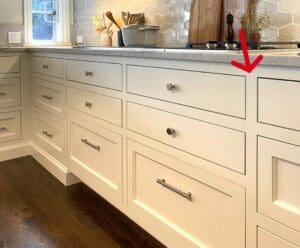
With Inset Cabinetry the doors and drawer fronts are Inset, between the frames or fronts of the cabinetry. Since the doors are inset, the face of the door and frame are flush with each other.
This provides a distinctly different look and feel than the other typical type of cabinetry, which is called Overlay. With Overlay, the doors and drawer fronts are on top of, or Overlayed on the cabinet frame or cabinet box.
Inset Cabinets vs. Overlay Cabinets: What’s the Difference and What is the Same?
Let’s start with what is the same. Both can be made in any theme or style. Both can be attractive and functional. Both come in a wide of quality levels and prices.
Design Differences
The difference is the visible frame between each door and drawer front. This distinctive look is quite different than Overlay. Inset Cabinetry just looks great. It is evocative of fine furniture and has a tailored built-in cabinetry look.
Inset Cabinetry has a more furniture look, because fine furniture is often built with Inset Doors or Inset Drawer Fronts.
Many Designers and Architects specify Inset Cabinetry because of the luxurious or high-end look that only Inset can achieve.
Inset Cabinetry tends to look more traditional because the door and drawer front style tends to be more traditional. Also for some “Period” looks, Inset Cabinetry is required.
However, Inset Cabinetry can also be Contemporary or Transitional. See picture below that used Paperstone doors and drawer fronts and had exposed Baltic Plywood cases and finger pulls.
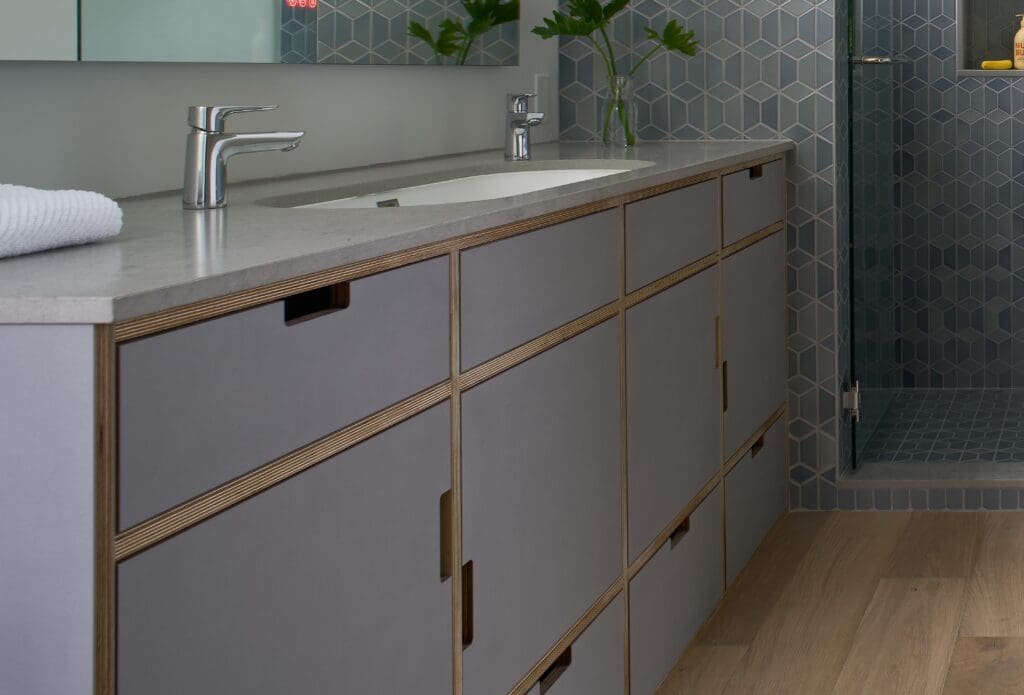
Cost
Inset Cabinetry has more pieces that have to be built, finished and installed so Inset Cabinetry is usually more expensive than Overlay Cabinetry. Also Inset Cabinetry requires a higher level of skilled craftmanship to manufacture. All of the frames which are visible have to be installed with precision. In addition, when the cabinetry is painted or stained, the frames and the doors and drawer fronts need to be finished to exact standards.
The Details
Now that we have provided an overview of Inset Cabinetry, let’s dive into a few of the details. The Frames!
Most Inset Cabinetry frames are 1-1/2” wide. They are also typically 7/8” thick as most cabinetry doors are ¾ “ thick, and with a rubber bumper added the doors and drawer fronts are 7/8 “ thick. By being the same thickness, it allows for the frame and the doors to be installed flush. Usually, the frame is installed in front of the cabinet box. See sketch below. Companies that produce high quality Inset Cabinets ensure that details such as door and frame thicknesses are adhered to.
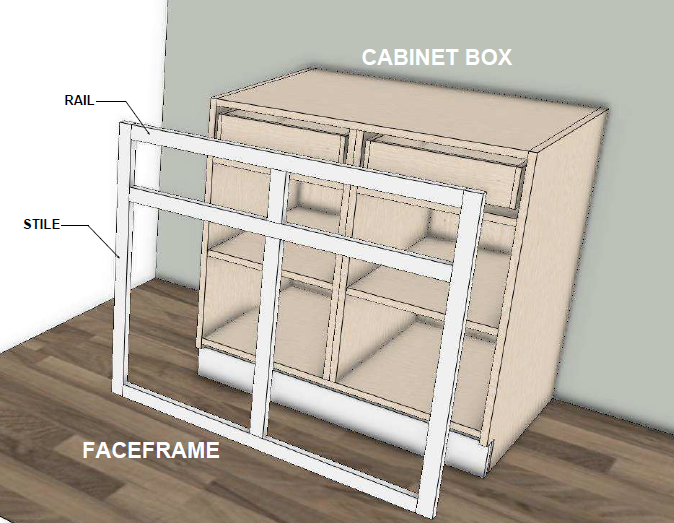
Frames are often flat like the Blue-Gray Painted Inset Cabinets pictured below.
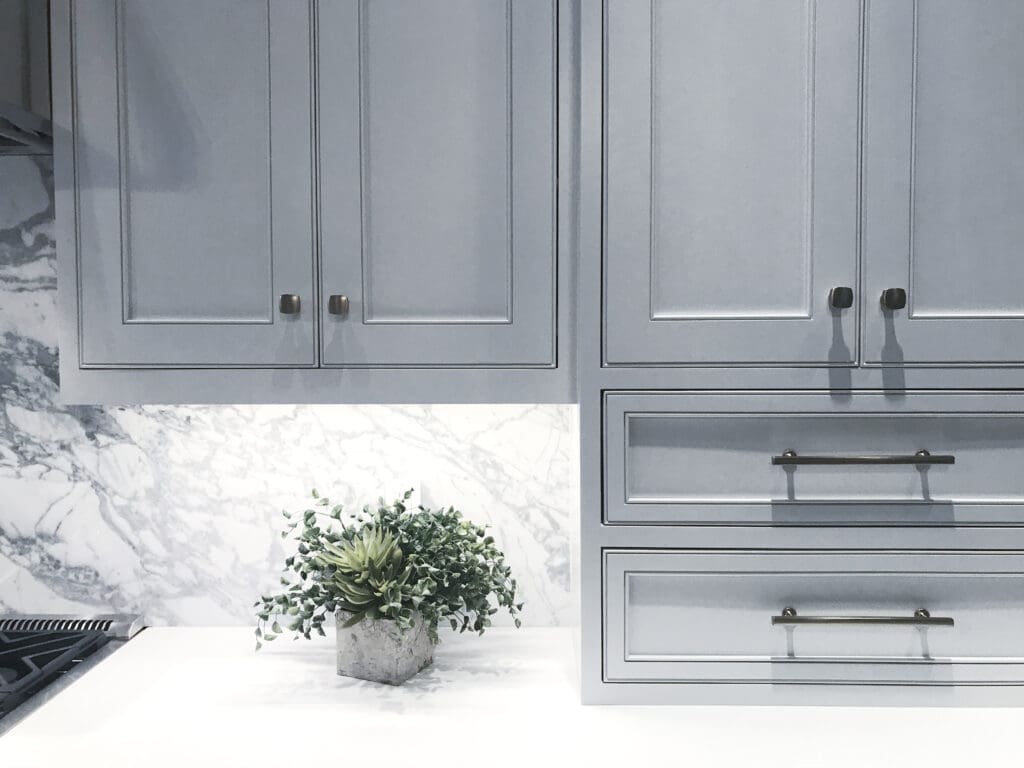
Another popular option is a Beaded Frame, which is shown in the White Inset Cabinetry pictured below. Beaded Frames add a traditional feel to Inset Cabinets. Beaded Frames require even more precise fabrication and installation and are typically more expensive than flat frames.
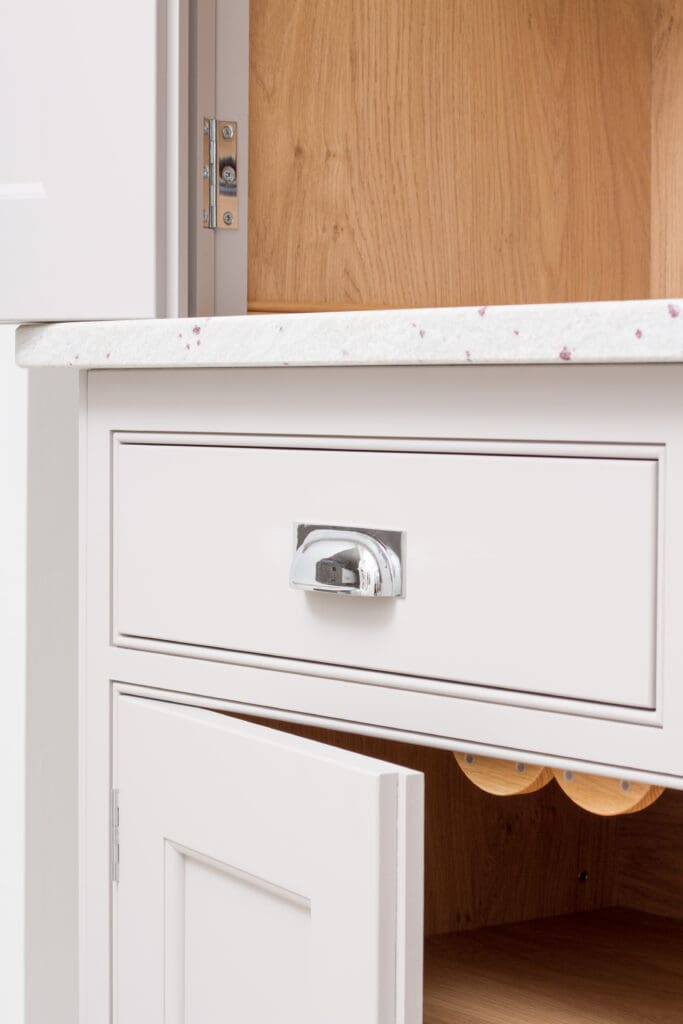
Stained Wood Inset Cabinetry
Real Solid Wood Inset Cabinetry was the original Inset Cabinetry. Typically, the frames and the doors and drawer fronts are made from the same type of wood and stained and finished the same.
The grain direction of the wood runs the same direction as the frame. The vertical pieces of the frame have vertical grain and the horizontal pieces have horizontal grain. Painted inset cabinets would be built the same and after painting you can’t see the grain.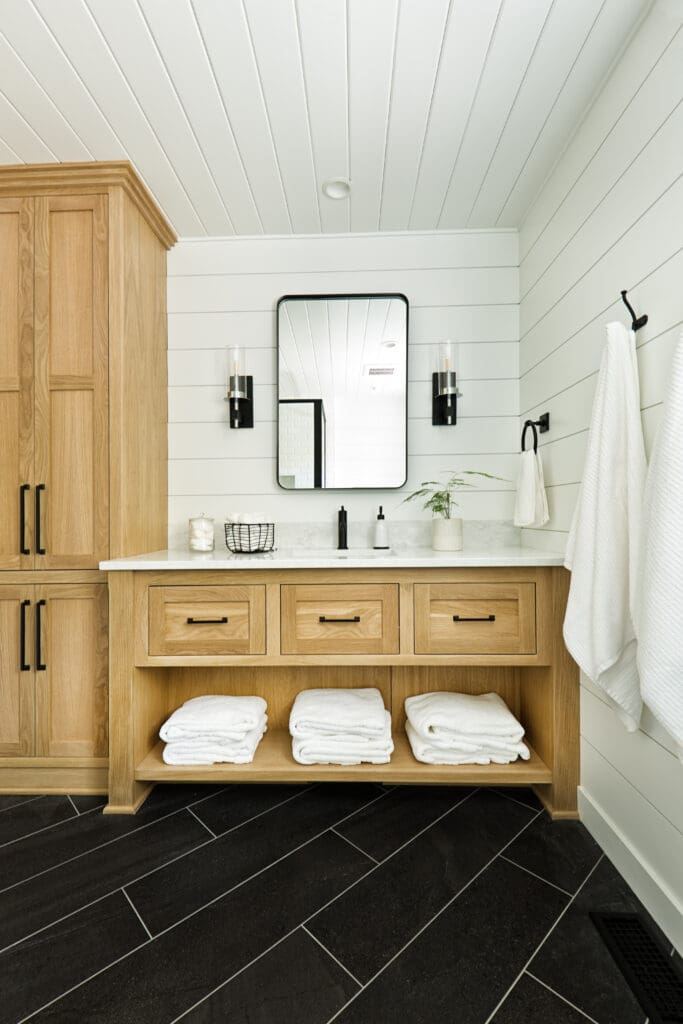
Location and Number Of Frames
Typically, there is a frame between every door and drawer front. You can achieve a Transitional or different look with fewer frames. As shown in the white vanity below there is no frame between each drawer front.
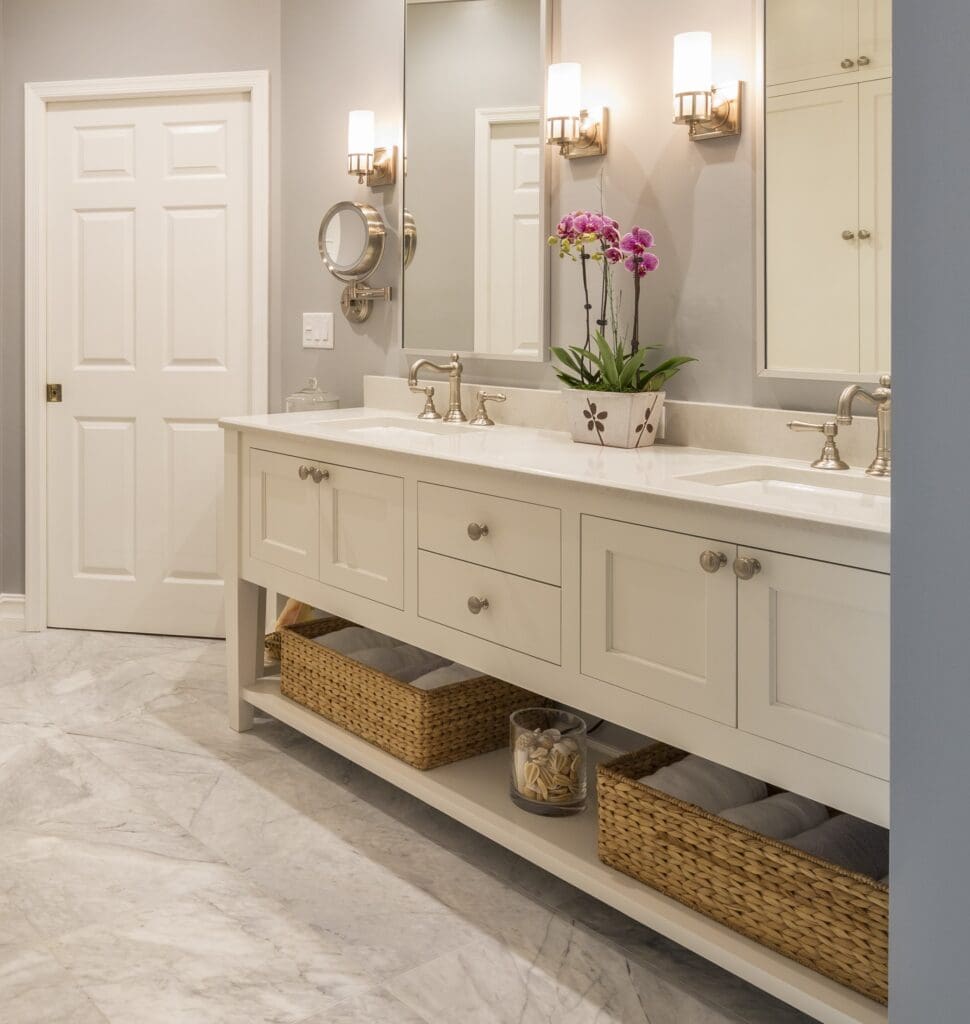
This provides both taller drawers and different look.
This is also less expensive to build as there are fewer pieces to fabricate and install.
This vanity still has the high-end furniture feel which Inset Cabinetry provides.
Earlier we spoke about how Inset Cabinetry frames are typically 1.5” wide and installed in front of the box.
Another option is to eliminate the frame, and just have the front edge of the box show as pictured in the grey Paperstone bathroom above. The edge of the plywood box is sanded and then gets a clear finish– the doors and drawer fronts are a different color.
Another options is to cover the front edge of the plywood is with real wood, also known as edge banding, and then painted the same color as the doors and drawer fronts.
A benefit is that since there is no added frame, there are fewer parts to fabricate and install, so this method is less expensive. Just one of the many ways that Inset Cabinetry can be used to achieve different looks.
Seams on Frames
High Quality Inset Cabinetry has no or very few visible seams or joints where the frame pieces meet each other. This is one of the reasons why Inset Cabinetry looks luxurious and high end. Notice in the picture below there is no vertical visible seam between each set of drawers. That is because this group of cabinetry was made as one piece. The frame that surrounds all nine drawer fronts was built as one frame. Then the one entire cabinetry piece was delivered and installed. This kind of grouping cabinets or ganging is usually only done by higher quality custom cabinet shops.
Another option for no seams is to have the cabinetry painted after installation. In this method all of the cabinetry and frames and adjacent trim is installed, and then all of the joints and nail holes are filled and sanded and then painted.
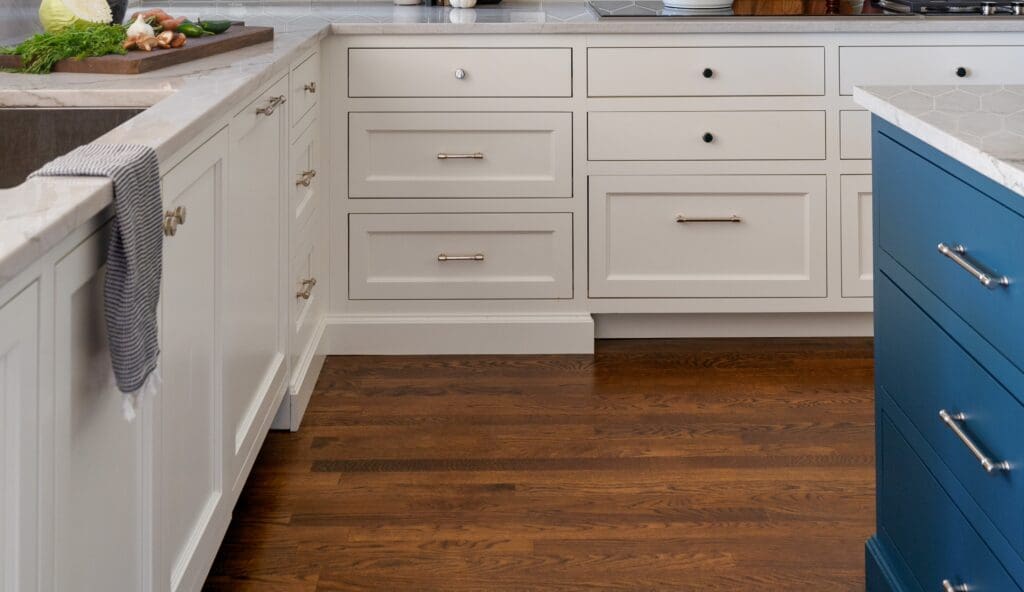
See picture below, These Two Cabinets were each made separately and then installed next to each other. While the vertical seam does detract from the high-end furniture look, they look nice and have many of the distinguishing characteristics of Inset Cabinetry. Inset Cabinetry made this way is usually less expensive than the ones ganged together.
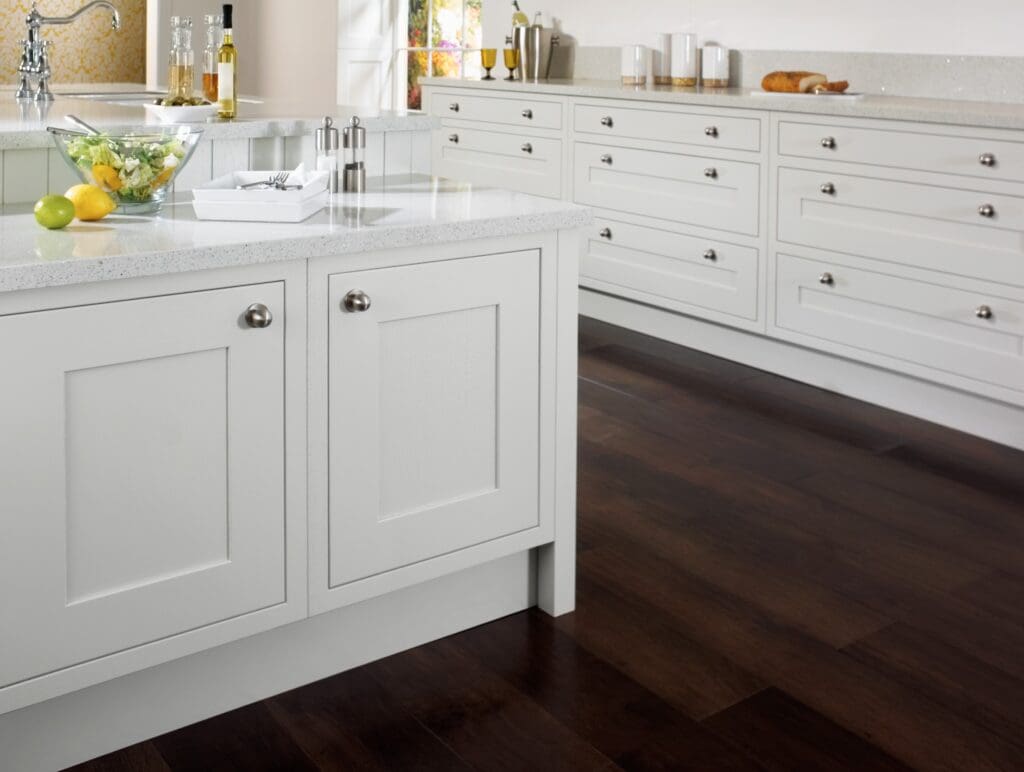
Mixing Inset and Overlay
Often designers and architects mix both Inset and Overlay Cabinetry in the same home or even the same room. When mixed in the same room, usually the Upper Cabinetry is Inset and the Lower Cabinetry is Overlay. The thought process is the more visible uppers are the distinctive Inset Cabinetry and the less visible Lowers are the less expensive Overlay.
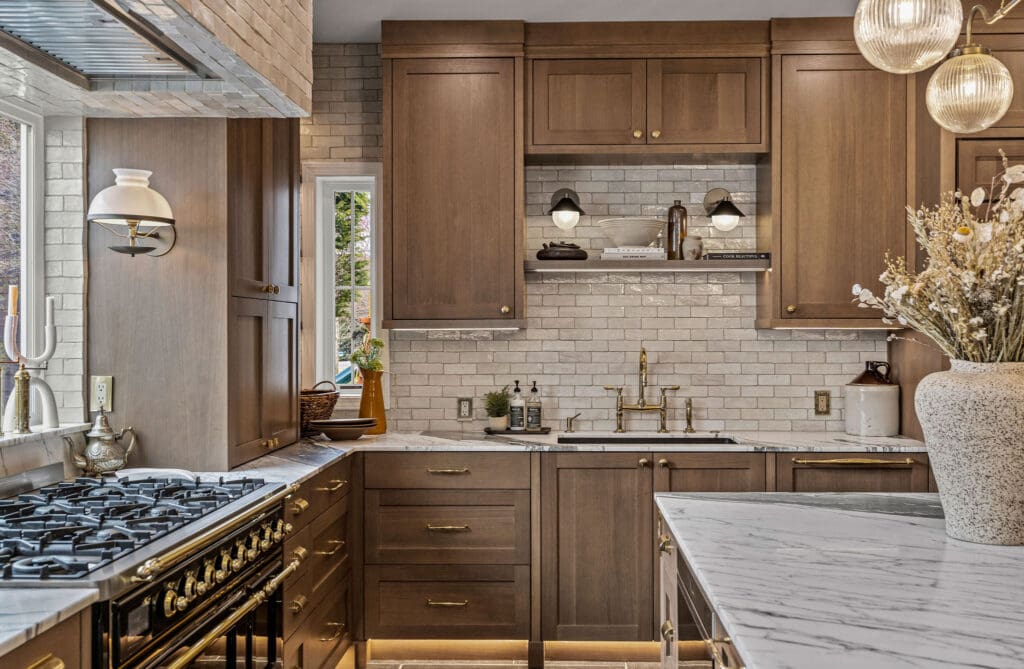
Modified Inset Cabinetry
This a term that we here at Urban Cabinets have coined ourselves, and it is catching on!
Modified Inset Cabinetry has some of the features of Inset Cabinets. In the picture below vertical fillers, also called pilasters, divide the Overlay cabinets and then Applied End Panels complete the look. While these are not true Inset Cabinets, they still have a polished upscale look and feel.
Modified Inset Cabinetry is usually priced more than Overlay and less than Inset. 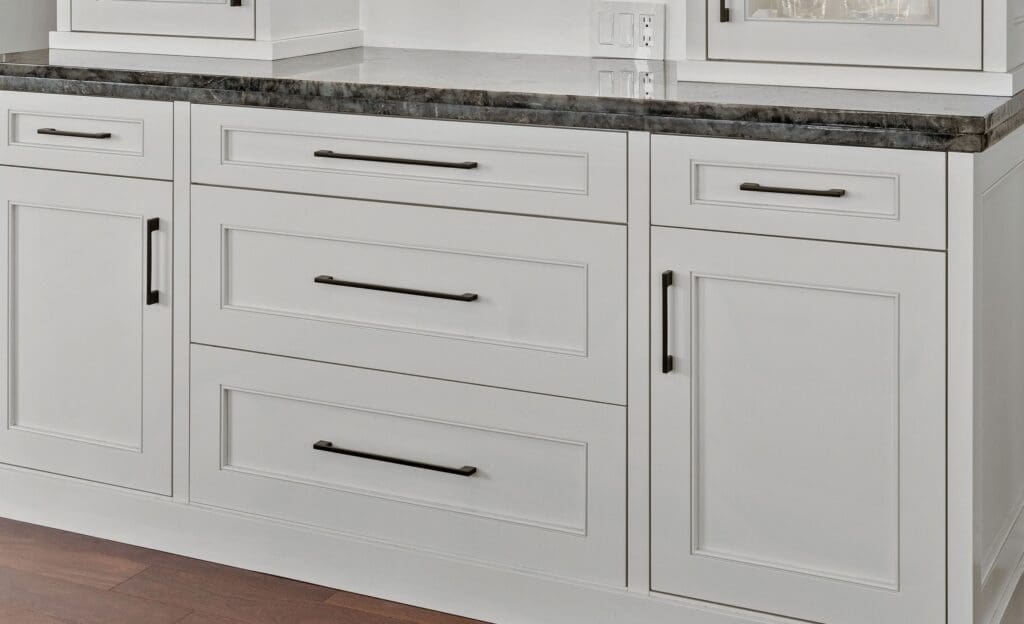
Bench Made – Hand Made
Most Inset Cabinetry is made by hand or what is also called “Bench Made”. The term Bench refers to the low flat table or bench that a cabinetmaker or furniture maker uses.
Bench Made cabinetry is typically higher end custom cabinetry made in medium sized or smaller shops that specialize in custom cabinetry and furniture.
By assembling cabinetry by hand, the manufacturer can ensure the highest quality.
Urban Cabinets manufactures Inset, Modified Inset and Overlay Cabinetry. All of the Cabinetry made by Urban Cabinets are Bench Made by highly skilled and experienced craftsmen. Our Designers are well versed in all of the issues discussed here and will help ensure your Cabinetry project is tailored to fit your design aesthetic and budget.

